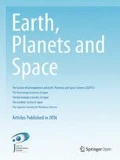Abstract
To better understanding the observation data, we attempt to assess the detectability for the crustal deformation observation network of the Hot Springs Research Institute of Kanagawa prefecture (HSRI). The HSRI has carried out continuous monitoring of crustal deformation with GPS, EDM, borehole tiltmeters, groundwater leveling since 1989. Our observation purpose is to detect the pre-, co- and post-seismic deformations of the hypothetical M7 class earthquake designated as the “Western Kanagawa Prefecture Earthquake (WKE)”. In order to estimate the detectability, weapplya simple calculation method, thatiscomparing between co-seismic deformation (displacement and tilt) and the accuracy of observation instruments. Co-seismic deformation is calculated using the Okada’s method, which is a formulation of the expected crustal deformation due to seismic faulting as a function of an earthquake magnitude and a hypocentral distance without assuming focal mechanism. It is indicated that the highest detectability area is located in the center of our HSRI observation network. Comparing detectability contour maps for several kinds of networks, we can find that the detectability of the co-seismic deformation by the tiltmeter network is higher than those by the GPS and EDM networks in the case of the M5 class earthquake with a focal depth of 10 km, and that the detectability by the GPS network is almost equal to that by the EDM network in the case of the M6 class earthquake with a focal depth of shallower than 15 km. For M4 class earthquakes, it is difficult for the GPS, EDM and tiltmeter networks to detect co-seismic deformation. The present result shows advantageous characteristics of the HSRI geodetic network and an important constraint on investigating the pre-, co- and post-seismic deformation of the WKE. To monitor the pre-, co- and post-seismic deformation of the WKE, it is necessary to combine these observations in the most effective way.
References
Hot Springs Research Institute of Kanagawa prefecture, Planning for the “West Kanagawa Earthquake” by the Hot Springs Research Institute of Kanagawa prefecture, Bulletin of the Hot Springs Res. Inst., 29-1/2, 3–40, 1999 (in Japanese).
Ishibashi, K., “Kanagawaken-Seibu-Earthquake” and earthquake prediction 1, Kagaku, 58, 537–547, 1988 (in Japanese).
Ishii, H. and T. Kato, Detectabilities of earthquake precursors using GPS, EDM and Strain meters, with special reference to the 1923 Kanto earthquake, J. Geod. Soc. Japan, 35, 75–83, 1989.
Kogita, S., Investigation of the detection capability of premonitory crustal deformation in the Tokai district, Bull. Earthq. Res. Inst., 60, 461–485, 1985 (in Japanese with English abstract).
Komukai, Y. and H. Ishii, On the detectability of earthquakes and crustal movements in and around the Tohoku district (Northeastern Honshu) (2) Crustal movements, J. Seismol. Soc. Japan, Ser. 2, 31, 445–455, 1978 (in Japanese with English abstract).
Okada, Y., Expected crustal deformation due to seismic faulting, Programme and Abstracts, Seismol. Soc. Japan, 2, 240, 1992 (in Japanese).
Okada, Y., Fault models for hypothetical “West Kanagawa earthquake” and anticipated crustal deformation fields, Journal of Geography, 102(4), 445–456, 1993 (in Japanese).
Sato, H., H. Takahashi, E. Yamamoto, N. Fukuo, M. Uehara, and Y. Terasawa, Development of the crustal tilt observation method using borehole-type tiltmeters, J. Seismol. Soc. Japan, Ser. 2, 29, 93–98, 1980 (in Japanese with English abstract).
Shimazaki, K., Observability of a foreslip on a hypothesized fault of the anticipated Tokai, Japan earthquake, Earthq. Pred. Res., 3, 637–649, 1985.
Tanada, T., H. Ito, K. Yamaki, S. Odaka, and T. Hirano, Automatic and continual GPS observation system by Hot Springs Research Institute of Kanagawa Prefecture, Bulletin of the Hot Springs Res. Inst., 26-1, 37–48, 1995 (in Japanese with English abstract).
Tsuneishi, Y., Continuous monitoring of crustal activity in east Izu Peninsula by automatic electronic distance measurement, J. Phys. Earth, 39, 131–139, 1991.
Yamaki, K., S. Odaka, H. Ito, T. Tanada, and Y. Oki, Tilt change analyzing system of Hakone volcano, Bulletin of the Hot Springs Res. Inst., 21-3, 17–32, 1990 (in Japanese with English abstract).
Author information
Authors and Affiliations
Corresponding author
Rights and permissions
About this article
Cite this article
Tanada, T. Detectability for GPS, EDM and tiltmeters of the Hot Springs Research Institute in the western Kanagawa prefecture, Japan. Earth Planet Sp 52, 1009–1013 (2000). https://doi.org/10.1186/BF03352322
Received:
Revised:
Accepted:
Published:
Issue Date:
DOI: https://doi.org/10.1186/BF03352322

